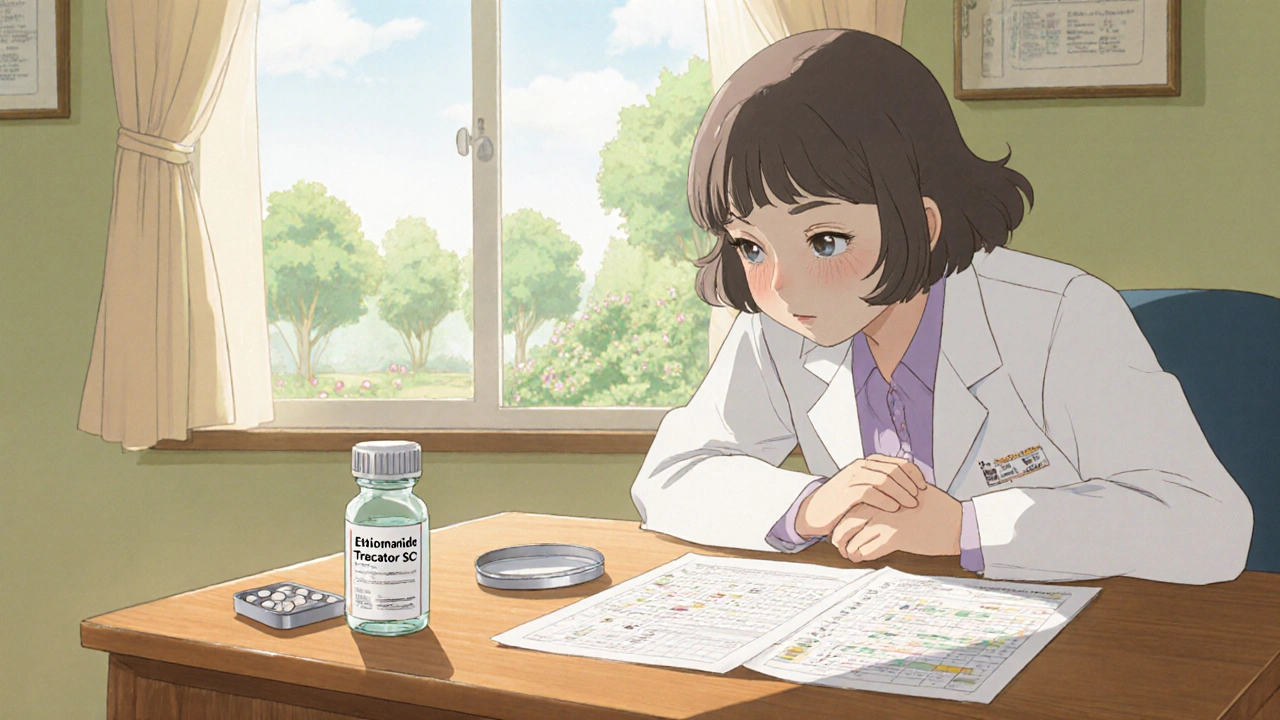MDR-TB Drug Selection Tool
Recommended Treatment
Quick Takeaways
- Ethionamide (Trecator SC) is a second‑line drug for MDR‑TB, taken once or twice daily.
- It works by blocking mycolic‑acid synthesis, similar to isoniazid but with a higher side‑effect profile.
- Common alternatives include rifampicin, isoniazid, fluoroquinolones, bedaquiline and delamanid.
- Choose an alternative based on resistance pattern, patient tolerance, drug‑interaction risk, and cost.
- Monitor liver function, thyroid, and visual acuity closely when using ethionamide or its peers.
When a patient is diagnosed with multidrug‑resistant tuberculosis (MDR‑TB), clinicians often reach for Trecator SC is the brand name for ethionamide, an oral antibiotic used to treat MDR‑TB. But ethionamide isn’t the only option on the shelf. This guide walks you through how ethionamide stacks up against its most widely used alternatives, what makes each drug unique, and how to decide which regimen fits a particular case.
Why Ethionamide Exists in the MDR‑TB Toolbox
Ethionamide belongs to the thioamide class of antibiotics. Its main job is to inhibit the enzyme InhA, which is essential for building the mycobacterial cell wall’s mycolic acids. By doing so, it stalls bacterial replication. It’s typically reserved for strains that are resistant to first‑line drugs like isoniazid and rifampicin, making it a cornerstone of the World Health Organization’s (WHO) MDR‑TB regimen.
Key attributes of ethionamide:
- Dosage: 15-20 mg/kg daily, usually split into two doses.
- Half‑life: 2-3 hours, but active metabolites linger longer.
- Common side effects: gastrointestinal upset, nausea, vomiting, peripheral neuropathy, and hepatotoxicity.
- Special considerations: Strong inducer of cytochrome P450; interacts with hormonal contraceptives and some antiretrovirals.
First‑Line Contenders: Rifampicin and Isoniazid
Most TB cases start with a four‑drug cocktail: rifampicin, isoniazid, pyrazinamide, and ethambutol. When resistance appears, the two big guns-rifampicin and isoniazid-often lose their punch.
Rifampicin is a bactericidal antibiotic that blocks RNA synthesis by targeting the bacterial RNA polymerase. It’s highly effective, cheap, and has a once‑daily dosing schedule, but resistance can develop quickly if used without companion drugs.
Isoniazid is a pro‑drug activated by the mycobacterial KatG enzyme, leading to inhibition of mycolic‑acid synthesis. It’s also cheap and well‑tolerated, yet many MDR‑TB strains carry katG mutations that render it useless.
Both drugs share some drawbacks: hepatotoxicity, drug‑drug interactions (especially with antiretrovirals), and the need for regular liver‑function monitoring.
Second‑Line Options: Fluoroquinolones, Bedaquiline, and Delamanid
When MDR‑TB is confirmed, clinicians reach for more potent, often newer agents.
Levofloxacin (representative fluoroquinolone) is a DNA‑gyrase inhibitor that impedes bacterial DNA replication. It’s taken once daily, has a relatively mild side‑effect profile, but can cause tendonitis and QT‑prolongation.
Bedaquiline is a diarylquinoline that blocks the mycobacterial ATP synthase, a novel mechanism not shared by older drugs. Approved in 2012, it’s given as a 400 mg loading dose for two weeks, then 200 mg three times per week. Its biggest concerns are hepatotoxicity and cardiac QT‑interval lengthening.
Delamanid is a nitro‑imidazooxazole that inhibits mycolic‑acid synthesis via a different pathway than ethionamide. It’s dosed at 100 mg twice daily. Similar to bedaquiline, QT‑prolongation is a watch‑out, and the drug is more expensive.

How Ethionamide Compares - A Side‑by‑Side Table
| Drug | Mechanism | Typical Dose | Major Side Effects | Place in Therapy | Cost (US$ per month) |
|---|---|---|---|---|---|
| Ethionamide | InhA inhibition (mycolic‑acid synthesis) | 15‑20 mg/kg daily (split BID) | GI upset, hepatotoxicity, peripheral neuropathy | Second‑line for MDR‑TB | ≈ 45 |
| Rifampicin | RNA polymerase inhibition | 10 mg/kg daily | Hepatotoxicity, orange fluids, drug interactions | First‑line (unless resistant) | ≈ 5 |
| Isoniazid | KatG‑activated mycolic‑acid synthesis blocker | 5 mg/kg daily | Hepatotoxicity, peripheral neuropathy | First‑line (unless resistant) | ≈ 3 |
| Levofloxacin | DNA‑gyrase inhibition | 500‑750 mg daily | Tendonitis, QT‑prolongation, GI upset | Second‑line fluoroquinolone | ≈ 30 |
| Bedaquiline | ATP synthase inhibition | 400 mg ×2 weeks, then 200 mg thrice weekly | QT‑prolongation, hepatotoxicity | Core drug for MDR‑TB | ≈ 900 |
| Delamanid | Mycolic‑acid synthesis via nitro‑reductase | 100 mg BID | QT‑prolongation, GI upset | Core drug for MDR‑TB (alternative to bedaquiline) | ≈ 750 |
When to Pick Ethionamide Over Its Peers
Choosing ethionamide makes sense in a few specific scenarios:
- Confirmed resistance to isoniazid and rifampicin but susceptibility to ethionamide on drug‑susceptibility testing (DST).
- Limited access to newer agents. In low‑resource settings, bedaquiline and delamanid may be unavailable or unaffordable.
- Patient can tolerate GI side effects. If a patient has a history of severe hepatotoxicity from rifampicin, ethionamide may be a safer alternative.
- Regimen simplification. Ethionamide can be combined with a fluoroquinolone and a later‑stage injectable (e.g., amikacin) to keep the pill burden manageable.
Conversely, avoid ethionamide when:
- Baseline liver enzymes are already elevated (risk of severe hepatotoxicity).
- Patient is on medications heavily metabolized by CYP450 (e.g., certain antiretrovirals).
- Pregnant or planning pregnancy - ethionamide is teratogenic in animal models.
Monitoring and Managing Side Effects
Because ethionamide shares many toxicities with other TB drugs, a robust monitoring plan is essential.
- Liver function: Check ALT/AST at baseline, then every two weeks for the first two months, then monthly.
- Thyroid function: Ethionamide can cause hypothyroidism; baseline TSH and repeat at 3‑month intervals.
- Neuropathy screening: Give pyridoxine (vitamin B6) 10‑50 mg daily to prevent peripheral neuropathy.
- Visual acuity: Though rare, optic neuritis can occur; schedule eye exams every 3 months.
If side effects become intolerable, switch to a fluoroquinolone or, where possible, to bedaquiline or delamanid, which have a different toxicity profile.

Cost and Accessibility Landscape (2025)
In 2025, global health agencies have pushed to lower the price of newer MDR‑TB drugs, but price gaps remain.
- Ethionamide: Generic versions cost roughly US$40‑50 per month in most LMICs.
- Rifampicin and Isoniazid: Widely available through national TB programs, typically under US$10 per month combined.
- Levofloxacin: Mid‑range cost, about US$30‑40 per month.
- Bedaquiline: Still expensive; donor‑supported programs can bring it down to US$800‑900 per month, but many patients pay out‑of‑pocket.
- Delamanid: Similar price tier to bedaquiline, with limited generic competition.
When budgeting for a treatment course, factor in additional costs for laboratory monitoring, pyridoxine supplementation, and possible hospitalisation for side‑effect management.
Practical Decision Tree for Clinicians
- Obtain drug‑susceptibility test (DST) results.
- Is the strain resistant to rifampicin and isoniazid?
• Yes → move to step 3.
• No → use standard first‑line regimen. - Is the strain susceptible to ethionamide?
• Yes → consider ethionamide + fluoroquinolone + injectable (if needed).
• No → proceed to step 4. - Are bedaquiline or delamanid available and affordable?
• Yes → incorporate whichever fits the patient’s cardiac profile (monitor QT).
• No → rely on fluoroquinolones plus cycloserine or PAS. - Assess liver function, pregnancy status, and drug‑interaction risk before finalising the regimen.
This flow helps keep the selection systematic, reduces guesswork, and aligns with WHO 2024 treatment guidelines.
Next Steps for Patients and Providers
If you’re a patient:
- Ask your doctor for a copy of your DST report.
- Keep a diary of any side effects - nausea, vision changes, or muscle aches.
- Never stop a drug abruptly without medical advice; resistance can develop fast.
If you’re a provider:
- Ensure baseline labs (LFTs, TSH, ECG) before starting ethionamide.
- Coordinate with local TB program for drug supply and possible financial aid.
- Educate patients on the importance of adherence - directly observed therapy (DOT) can be lifesaving.
Frequently Asked Questions
How long does a typical ethionamide course last?
Ethionamide is usually given for 6‑9 months as part of a combination regimen, depending on sputum conversion and DST results.
Can ethionamide be used during pregnancy?
Animal studies show teratogenic effects, and the WHO classifies it as a Category C drug. It is generally avoided unless the benefits outweigh the risks and no safer alternatives exist.
What makes ethionamide different from isoniazid?
Both target mycolic‑acid synthesis, but ethionamide binds directly to InhA, while isoniazid requires activation by KatG. This difference means some isoniazid‑resistant strains remain susceptible to ethionamide.
Is pyridoxine necessary with ethionamide?
Yes. Pyridoxine (vitamin B6) at 10‑50 mg daily reduces the risk of peripheral neuropathy, a common side effect of ethionamide and isoniazid.
How does the cost of ethionamide compare to bedaquiline?
Ethionamide is roughly US$45 per month as a generic, while bedaquiline can exceed US$800 per month, even with donor subsidies. This makes ethionamide the more affordable option in many low‑resource settings.
Armed with this side‑by‑side view, you can weigh the pros and cons of ethionamide against its peers and pick a regimen that matches the patient’s resistance pattern, health status, and financial reality.


When you're managing MDR‑TB, the side‑effect profile of ethionamide can be a real burden for patients, so it’s crucial to set realistic expectations early. I always stress that monitoring liver enzymes and thyroid function isn’t optional – it’s part of the therapeutic contract. If you catch hepatotoxicity early, you can adjust the regimen before the patient feels hopeless. Also, supplementing with pyridoxine can blunt the neuropathy that many folks dread. Ultimately, feeling heard while staying on track makes the difference between success and dropout.
Ethionamide’s pharmacodynamics merit a nuanced appraisal beyond its superficial classification as a “second‑line” agent. By directly inhibiting the enoyl‑ACP reductase InhA, it circumvents the KatG activation pathway requisite for isoniazid efficacy, thereby retaining activity against katG‑mutant Mycobacterium tuberculosis isolates. The drug’s absorption kinetics reveal a bioavailability of approximately 70 %, with a dose‑proportional increase in plasma concentration up to 20 mg kg⁻¹ day⁻¹, after which saturation of hepatic metabolism occurs. Its metabolic fate involves oxidation by CYP2C19 and conjugation via glucuronidation, processes that predispose to clinically significant drug‑drug interactions, particularly with antiretroviral agents that are CYP substrates. The resultant metabolites possess a half‑life extending beyond the parent compound’s 2–3 hour window, contributing to cumulative toxicity profiles during prolonged therapy. Gastrointestinal intolerance, notably nausea and vomiting, is reported in up to 30 % of patients, necessitating adjunctive anti‑emetic regimens to sustain adherence. Hepatotoxicity, characterized by transaminase elevations exceeding threefold the upper limit of normal, warrants bi‑weekly monitoring in the initial two months, aligning with WHO recommendations for MDR‑TB protocols. Thyroid suppression, manifested as subclinical hypothyroidism, can emerge secondary to interference with iodine organification, thus baseline and quarterly TSH assessments are prudent. Peripheral neuropathy, while less frequent than with isoniazid, may be mitigated by routine pyridoxine supplementation at 10–50 mg daily. From a resistance perspective, mutations in ethA and inhA promoter regions confer high‑level resistance, underscoring the necessity of susceptibility testing prior to inclusion in a regimen. Cost analyses in low‑resource settings reveal an estimated monthly expenditure of US $45, a figure markedly lower than the $800‑plus associated with bedaquiline, rendering ethionamide a financially viable option where newer agents are inaccessible. Nevertheless, the economic advantage must be balanced against the heightened monitoring burden, which can inflate indirect costs through laboratory and clinical visits. Comparative efficacy data indicate cure rates approximating 65 % when ethionamide is integrated into optimized combination therapies, a figure modestly inferior to the 80 % observed with bedaquiline‑containing regimens but still acceptable within constrained health systems. In summary, ethionamide occupies a pivotal niche for MDR‑TB strains susceptible to its mechanism, provided that clinicians institute rigorous pharmacovigilance, adjust dosing in accordance with hepatic function, and counsel patients regarding the anticipated adverse event trajectory.
Yo, I get that ethionamide sounds scary, but think of it as a backstage hero in the TB fight. When the first‑line drugs bail, this guy swoops in and keeps the bacteria guessing. A little nausea here, a bit of liver check there – that’s the price of winning the marathon. Keep the pyridoxine handy, stay on top of labs, and you’ll see those sputum cultures finally turn negative. Trust the process and keep the morale high, because every pill is a step toward freedom.
Ethionamide should be considered when DST confirms susceptibility and first‑line agents fail. Administer 15–20 mg kg⁻¹ day⁻¹ in divided doses, monitoring LFTs bi‑weekly. Adjust dosage promptly if transaminases exceed three times ULN.
The economics of MDR‑TB treatment force us to confront a harsh truth: cheaper drugs like ethionamide come with a hidden surveillance cost that wealthier health systems can absorb. While bedaquiline dazzles with higher cure rates, its price tags keep it out of reach for most patients, perpetuating a cycle of inequity. Ethionamide, though modest in efficacy, democratizes access, yet we must not let cost dictate complacency in patient monitoring. If we prioritize fiscal prudence over comprehensive care, we risk undermining the very goal of eradication. The moral imperative is clear – invest in the infrastructure that supports safe ethionamide use, or accept the devastating alternative.
Ethionamide looks like a budget‑friendly option, but its side‑effects can feel like a roller‑coaster. The liver can turn hostile, and the nerves might tingle. Give patients pyridoxine, keep an eye on labs, and the drama stays on the screen, not in the clinic.
Look at the global supply chain and you see how powerful institutions control who gets what and who doesn’t but the narrative pushed by pharma giants about new drugs hiding the fact that cheap alternatives like ethionamide are being sidelined for profit reasons while patients suffer in silence the regulatory bodies claim they need more data to approve bedaquiline yet the data already exists the political agenda obscures the simple truth that the cheapest drug can save lives if we only gave it a fair chance the public health community must demand transparency and equitable distribution the cost of ignoring ethionamide isn’t just dollars it’s lives lost to preventable disease the system is rigged and it’s time to rewrite the script before more people pay the ultimate price.